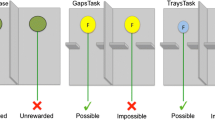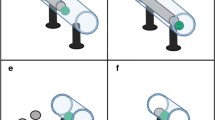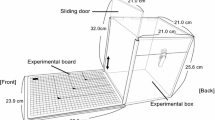Abstract
Recent research with Rooks has demonstrated impressive tool-using abilities in captivity despite this species’ classification as a non-tool-user in the wild. Here, we explored whether another non-tool-using corvid, the Eurasian Jay, would be capable of similar feats and investigated the relative contributions of causal knowledge and instrumental conditioning to the birds’ performance on the tasks. Five jays were tested on a variety of tasks involving water displacement. Two birds reliably interacted with the apparatuses. In these tasks, both birds showed a preference for inserting stones into a tube containing liquid over a tube containing a solid or a baited ‘empty’ tube and also for inserting sinkable items over non-sinkable items into a tube of water. To investigate the contribution of instrumental conditioning, subjects were then tested on a series of tasks in which different cues were made available. It was found that, in the absence of any apparent causal cues, these birds showed a clear preference for the rewarded tube when the food incrementally approached with every stone insertion, but not when it simply “appeared” after the correct number of stone insertions. However, it was found that subjects did not prefer to insert stones into a tube rewarded by the incremental approach of food if the available causal cues violated the expectations created by existing causal knowledge (i.e. were counter-intuitive). An analysis of the proportion of correct and incorrect stone insertions made in each trial across tasks offering different types of information revealed that subjects were substantially more successful in experiments in which causal cues were available, but that rate of learning was comparable in all experiments. We suggest that these results indicate that Eurasian jays use the incremental approach of the food reward as a conditioned reinforcer allowing them to solve tasks involving raising the water level and that this learning is facilitated by the presence of causal cues.









Similar content being viewed by others
Notes
This may have been because on the first trial the wax-worm in the substrate tube escaped from its float and climbed the stones he had dropped, bringing itself into easy reach. He was thus rewarded for putting stones into the substrate tube, perhaps leading him to expect to be able to retrieve a worm from this tube after future stone-drops.
Often in fact they would not need to hit it more than once, thus their actions would receive immediate reinforcement.
References
Bird C, Emery NJ (2009a) Insightful problem solving and creative tool modification by captive nontool-using rooks. Proc Natl Acad Sci 106:10370–10375
Bird C, Emery NJ (2009b) Rooks use stones to raise the water level in order to reach a floating worm. Curr Biol 19:1410–1414
Boesch C, Boesch H (1983) Optimisation of nut-cracking with natural hammers by Wild Chimpanzees. Behaviour 83:256–286
Bugnyar T, Heinrich B (2005) Ravens, Corvus corax, differentiate between knowledgeable and ignorant competitors. Proc R Soc Biol Sci 272:1641–1646
Chappell J, Kacelnik A (2002) Tool selectivity in a non-primate, the New Caledonian Crow (Corvus moneduloides). Anim Cognit 5:71–78
Chappell J, Kacelnik A (2004) Selection of tool diameter by New Caledonian Crows Corvus moneduloides. Anim Cognit 7:121–127
Clayton NS, Dickinson A (1998) Episodic-like memory during cache recovery by scrub-jays. Nature 395:272–278
Correia SP, Alexis DM, Dickinson A, Clayton NS (2007) Western scrub-jays (Aphelocoma californica) anticipate future needs independently of their current motivational state. Curr Biol 17:856–861
Dally JM, Emery NJ, Clayton NS (2004) Cache protection strategies by western scrub-jays (Ap helocoma californica): hiding food in the shade. Proc R Soc Lond B 271:S387–S390
Dally JM, Emery NJ, Clayton NS (2005) Cache protection strategies by western scrub-jays, Aphelocoma californica: implications for social cognition. Anim Behaviour 70:1251–1263
Dally JM, Emery NJ, Clayton NS (2006) Food-caching western scrub-jays keep track of who was watching when. Science 312:1662–1665
Emery NJ, Clayton NS (2001) Effects of experience and social context on prospective caching strategies in scrub-jays. Nature 414:443–446
Holzhaider JC, Hunt GR, Campbell VM, Gray RD (2008) Do wild New Caledonian Crows (Corvus moneduloides) attend to the functional properties of their tools? Anim Cognit 11:243–254
Hunt GR, Gray RD (2002) Species-wide manufacture of stick-type tools by New Caledonian Crows. Emu 102:349–353
Lefebvre L, Nicolakakis N, Boire D (2002) Tools and brains in birds. Behaviour 139:939–973
Lockie JD (1956) The food and feeding behaviour of the jackdaw, rook and carrion Crow. J Anim Ecol 25:421–428
Pearce JM, Hall G (1980) A model for pavlovian learning: variations in the effectiveness of conditioned but not of unconditioned stimuli. Psychol Rev 87:532–552
Prior H, Schwarz A, Güntürkün O (2008) Mirror-induced behaviour in the magpie (Pica Pica): evidence of self-recognition. PloS Biol 6(8):e202
Raby CR, Alexis DM, Dickinson A, Clayton NS (2007) Planning for the future by western scrub-jays. Nature 445:919–921
Rescorla RA, Wagner AR (1972) A theory of Pavlovian conditioning: Variations in the effectiveness of reinforcement and nonreinforcement. In: Black AH, Prokasy WF (eds) Classical Conditioning II: Current Research and Theory. Appleton Century Crofts, New York, pp 64–99
Seed AM, Tebbich S, Emery NJ, Clayton NS (2006) Investigating physical cognition in rooks, Corvus frugilegus. Curr Biol 16:697–701
Seed AM, Clayton NS, Emery NJ (2007) Postconflict third-party affiliation in rooks, Corvus frugilegus. Curr Biol 17:152–158
Seed AM, Clayton NS, Emery NJ (2008) Cooperative problem solving in rooks (Corvus frugilegus). Proc R Soc B Biol Sci 275:1421–1429
Shettleworth SJ (2010) Cognition, Evolution and Behaviour, 2nd Edition edn. Oxford University Press, New York
Taylor AH, Hunt GR, Holzhaider JC, Gray RD (2007) Spontaneous metatool use by New Caledonian Crows. Curr Biol 17:1504–1507
Taylor AH, Hunt GR, Medina FS, Gray RD (2009) Do New Caledonian Crows solve physical problems through causal reasoning? Proc R Soc B 276:247–254
Taylor AH, Medina FS, Holzhaider JC, Lindsay JH, Hunt GR, Gray RD (2010a) An investigation into the cognition behind spontaneous string pulling in New Caledonian Crows. PLoS One 5:e9345
Taylor AH, Eiliffe D, Hunt G, Gray RD (2010) Complex cognition and behavioural innovation in New Caledonian Crows. In: Proceedings of the Royal Society B, published online before print April 21, 2010
Tebbich S, Seed AM, Emery NJ, Clayton NS (2007) Non-tool-using rooks, Corvus frugilegus, solve the trap-tube problem. Anim Cognit 10:225–231
Visalberghi E, Addessi E, Truppa V, Spagnoletti N, Ottoni E, Izar P, Fragaszy D (2009) Selection of effective stone tools by wild bearded capuchin Monkeys. Curr Biol 19:213–217
von Bayern AMP, Heathcote RJP, Rutz C, Kacelnik A (2009) The role of experience in problem solving and innovative tool use in Crows. Curr Biol 19:1965–1968
Weir A, Chappell J, Kacelnik A (2002) Shaping of hooks in New Caledonian Crows. Science 297:981
Wimpenny JH, Weir AAS, Clayton L, Rutz C, Kacelnik A (2009) Cognitive processes associated with sequential tool use in New Caledonian Crows. PLoS One 4:e6471
Acknowledgments
We are extremely grateful to Elsa Loissel, Tony Dickinson, Bill McGrew and James Thom for discussion and to Brian McCabe for all his statistical advice, and a special thanks to Nathan Emery for all his help. We also thank Charmaine Donovan and Ivan Vakrilov for caring for the birds and Ian Miller for apparatus construction. Lucy Cheke was funded by an MRC studentship, and Chris Bird was funded by a BBSRC studentship. The studies were funded by grants from the BBSRC and the University of Cambridge.
Author information
Authors and Affiliations
Corresponding author
Additional information
An erratum to this article can be found at http://dx.doi.org/10.1007/s10071-011-0384-7
Electronic supplementary material
Below is the link to the electronic supplementary material.
Supplementary material 1 (WMV 2403 kb)
Supplementary material 2 (WMV 10307 kb)
Supplementary material 3 (WMV 3022 kb)
Supplementary material 4 (WMV 6327 kb)
Rights and permissions
About this article
Cite this article
Cheke, L.G., Bird, C.D. & Clayton, N.S. Tool-use and instrumental learning in the Eurasian jay (Garrulus glandarius). Anim Cogn 14, 441–455 (2011). https://doi.org/10.1007/s10071-011-0379-4
Received:
Revised:
Accepted:
Published:
Issue Date:
DOI: https://doi.org/10.1007/s10071-011-0379-4




